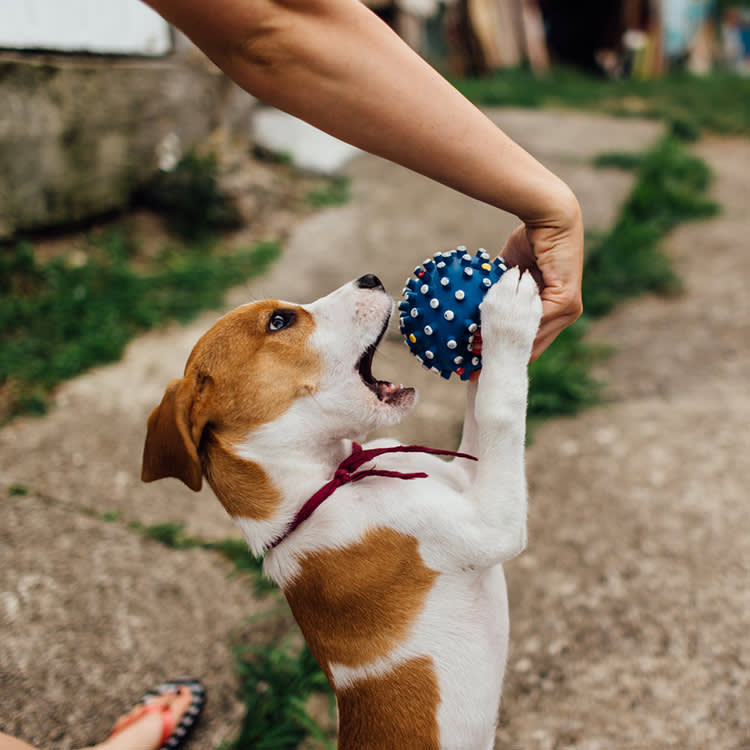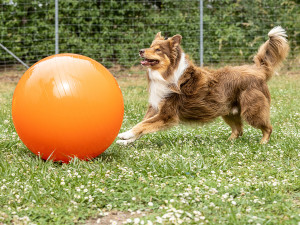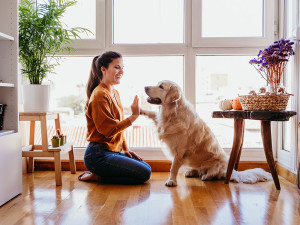Playing With Dogs Improves Their Training Success
Post-training play may extend a dog’s memory of previously learned behaviors by up to a year.

Share Article
For decades, a component of the current pet-dog training approach is the “play-before-you-train” model, wherein pet parents are advised to play with their pups — tug of waropens in a new tab, fetchopens in a new tab, chase gamesopens in a new tab — before attending a training class. The idea is to take the edge off the dog’s energy so they’re more able to focus on the lessons.
A calm demeanor makes it significantly easier for people to engage in the training course. Instead of spending time trying to force an angsty pup to cooperate, pet parents can maintain the dog’s attention and breeze through the class like a pro. But wait, if this practice is tried-and-true, what could possibly disrupt it? Turns out, we may have been doing things backward.

Get (totally free) deals for food, treats, accessories, tech, and way more pet parenting must-haves.
opens in a new tabStudying Post-Learning Play
In a 2017 study opens in a new tab on playful activities after training sessions, researchers, including Dr. Nadja Affenzelleropens in a new tab, found that play improved a dog’s training retention for 24 hours. To demonstrate this phenomenon, Dr. Affenzeller tested a small group of 11 Labrador Retrievers, ages three to 10 years old, in a “discrimination” task. This required the dog to choose between two different objects: a blue basket full of woodchips and a green box containing kitty litter.
Once the dogs were considered successful at the task, they either rested for 30 minutes in the presence of their person and one of the researchers, or were active for 30 minutes. Dogs in the “play” group did 10 minutes of walking on leash, then 10 minutes of off-leash play (fetch with a ball or with a disc or tug, depending on the dog’s preference), then 10 more minutes of walking on leash. The dogs in each group were monitored for salivary cortisol levels and heart rate to confirm that their states of physiological arousal were different. (They were.)
The following day, all of the dogs were tested again to see how many trials it took them to relearn the task. The difference between the two groups was remarkable. The dogs who walked and played after training took an average of 26 trials to relearn the task. The dogs who rested after training needed an average of 43 trials to reach that same level of success. The differences could be a result of chemical changes in the brain.
Expanding Training Success One Year Later.
Dr. Nadja Affenzeller’s follow-up researchopens in a new tab seems to not only confirm the previous results in an expanded study across one year, but has the potential to turn dog training as we know it on its head. This retention is facilitated by the release of adrenaline and the activation of specific parts of the dog’s sympathetic nervous system due to the excitement of playtime. Together, signals firing off in the nerve cells and amygdala (the part of the brain responsible for a pup’s emotions as well as some memory) seem to boost the dog’s long-term memory for up to a year.
Take two of the adorable test subjects, Max and Poppy, for example. For the previous study, they had been trained to identify the blue woodchip-filled basket from among other objects presented to them. At the command, “Go,” Max and Poppy were required to place two paws close to their chosen item in at least 16 out of 20 trials to be considered successful.
There was a catch, though. Max and Poppy, along with the other nine dogs, had different experiences after their earlier training sessions. Whereas Max relaxed on a dog bed, Poppy was in the “play” group and taken for a walk and given an opportunity to play with her person.
When they were tested with the same objects a year later, Poppy’s group, known as the “play group,” blew Max’s “resting group” out of the water. The playful pups only needed an average of 23 trials to refresh their memories in identifying their assigned objects. On the other hand, the resting dogs needed 50 trials on average to reach the same milestone. When Dr. Affenzeller further analyzed the data, she noted that Poppy and the rest of the playful dogs also made notably fewer errors in the second year’s test than Max and his chilled-out buddies.
Since there were so few dogs in this study, it can only be considered an indicator for what may become a brand-new approach in pet-dog training. Still, the question remains: How is this important to dog ownership as it stands today?
The Significance of Behavioral Training in Human-Dog Relationships
Acceptable behavior remains one of the major factors in people’s satisfaction with their canine companions. This is not only a matter of simple happiness within a given household, but also, an element that holds significant influence over a dog’s quality of life. Results of a study released in 2008opens in a new tab illustrated the degree to which training can affect a dog’s life, especially those who are on the sometimes difficult path toward finding their forever homes.
Examination of a sample of 5,750 dogs rehomed by the UK-based Dogs Trust revealed that “behavioral problems” were the leading cause of the relinquishment of a pet to a shelter, accounting for 58.6 percent of returns. Of the 2,185 pups who were returned, this resulted in a profound life disruption for approximately 1,280 of them — a devastating number for something so preventable.
The possibility of being surrendered to a shelter is not the only risk faced by dogs who do not receive adequate behavioral training. These pups are also vulnerable to being inappropriately abandoned or even euthanized if pet parents decide they’ve had enough. (More than 10 percent of dogs in the United Kingdom were returned, abandoned or euthanized as a direct result of personal dissatisfaction with behavior. Of those returned, 40 percent were eventually euthanized after living in the shelter for an extended period.)
Another study in 2018opens in a new tab revealed a similarly problematic relationship between Dutch pet parents’ satisfaction and unruly pets. After surveying 977 participants, researchers learned that disobedience and aggression were among the most prominent behavioral issues plaguing dog parents; both had significant negative correlations with pet parent satisfaction. Fortunately, most respondents (89 percent) reported having addressed these problems by using food and play during training (those who used play alone comprised 57 percent of training-course attendees).
Formal training-course enrollment is not necessarily predictive of increased pet parent-satisfaction levels. However, this study illustrated that when pet parents are better equipped to train their dogs using appropriate aids (i.e., play and food), the odds of improving both dog behavior and pet parent happiness rise dramatically.
According to results of a survey distributed by Vet Streetopens in a new tab, most people train their dogs to some degree, either professionally (46.7 percent) or on their own (45.5 percent). Those who attend formal training courses often enroll in multi-course programs (47.5 percent). An additional 30 percent of dog parents extend training by several weeks to earn some type of official certification.
Given how widespread the inclination to train pet dogs is, and the significance this practice has for both the quality of the dog’s and human’s life, Dr. Affenzeller’s findings could lead to dramatic improvements in dog-training success in the years to come.
If pet parents can take advantage of such an easy training tool to achieve a higher level of agency in the quality and efficiency of training, we may begin to see a gradual downturn in the number of companion dogs surrendered. Further, as pet parents brace for the inevitable return to work after Covid-19 restrictions are safely lifted, they may face a reckoning when attempting to re-establish boundaries with overly bonded dogs. Effective behavioral training will be more important than ever to ensure that dogs and their human companions are able to maintain a positive quality of life into the short- and long-term future.

Jazmin "Sunny" Murphy
Jazmin "Sunny" Murphy is a science communicator. Since 2015, she's been producing life science content in easy-to-understand language. You can learn more about her and her science writing and reporting work on her website Black Flower Writing Services.
Related articles
![A woman holding her dog close.]() opens in a new tab
opens in a new tabFYI, Your Dog Can’t Stand When You Do These 7 Things
Thanks, they hate it.
![Afghan hound dog mid jump in an open grass field]() opens in a new tab
opens in a new tabOverexcited Dog? How to Calm A Dog Down
If your dog loses their sh*t over anything—from a squirrel to a guest. Here are some tips to curtail that.
![A woman wearing a yellow headband and a white off-the-shoulder shirt with blue jeans and platform black flower boots kneeling next to her black Poodle mix dog on the lawn outside]() opens in a new tab
opens in a new tabHow to Teach Your Dog Your Name
Your dog might not know your name. Don’t take offense; just play this game.
![A woman holding a dogs paw and smiling.]() opens in a new tab
opens in a new tabNine Useful Tricks to Teach Your Dog
Go beyond the basics.





